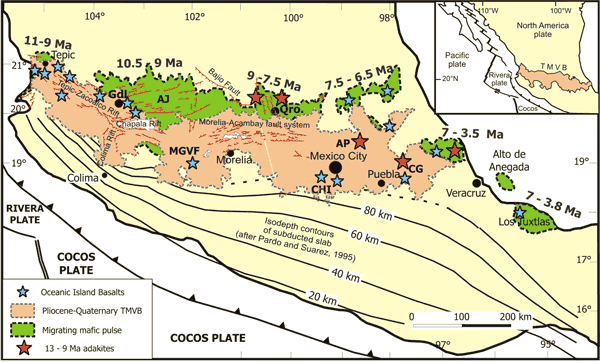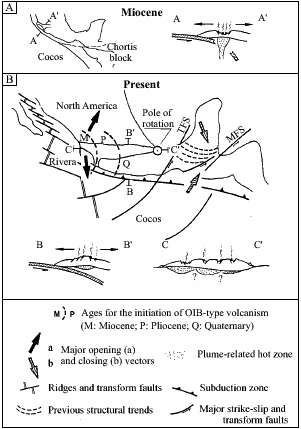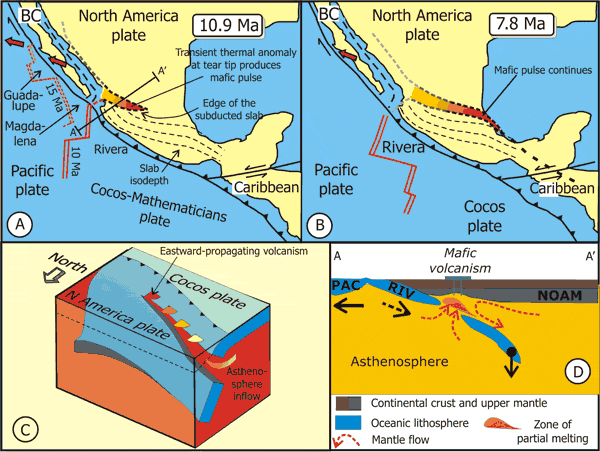 |
 |
The
Geochemical Puzzle of the Trans-Mexican Volcanic
Belt: Mantle
Plume, Continental Rifting, or Mantle Perturbation
Induced by Subduction?
|
|
|
Introduction
The Trans-Mexican
Volcanic Belt (TMVB) is the Neogene volcanic arc
built on the southern edge of the North American
plate (Ferrari et al.,
1999) (Figure 1). TMVB volcanism presents a wide
range of chemical compositions. The geochemical
signature of fluids from the subducting plate varies
strongly and lavas with a slab melting fingerprint
have been reported from several locations. Small
amounts of lavas with an intraplate (or OIB) signature
are found side by side with those with a subduction
signature and with similar ages. In addition, seismicity
associated with the subducting Cocos plate is abundant
in the forearc region but ends rather abruptly just
to the south of the TMVB at around 100 km depth
(Figure 1) where the upper mantle has a relatively
low density and high temperature. The geochemical
diversity and absence of seismicity beneath the
TMVB prompted several workers to develop genetic
models at variance with a classic subduction scenario.

Figure 1. Simplified geologic
map of Neogene volcanism and faults in central Mexico
(modified after Ferrari, 2004). Note the eastward
migrating pulse of mafic volcanism to the north
of the Plio-Quaternary TMVB and its possible continuation
to the southeast along the gulf of Mexico. GDL=Guadalajara;
AJ=Altos de Jalisco; QRO=Queretaro; CIII=Sierra
Chichinautzin; AP=Apan volcanic field; CG=Cerro
Grande volcanic complex; MGVF=Michoacan-Guanajuato
volcanic field. Click on image to enlarge.
|
The
plume model
Moore et al.
(1994) first suggested the presence of a mantle
plume beneath Guadalajara. This model was later
expanded by Marquez et al.
(1999), who proposed that the entire TMVB is related
to a mantle plume that impacted western Mexico
in the late Miocene. In the model of Marquez
et al. (1999) the plume first broke the subducting plate but the plate will
eventually take revenge by cutting off the plume
head (Figure 2).
Both
models were based mostly on geochemistry and are
inconsistent with the geology and tectonics of
the TMVB. In their comment to the paper of Marquez
et al. (1999) Ferrari
& Rosas (1999) showed that:
-
neither
the rifting nor the OIBs present the age progression
required by the plume model;
-
in western
Mexico, where the plume should have impacted,
there is no evidence of regional uplift;
-
the volume
of OIB lava in the TMVB is only a fraction
that of the subduction-related volcanism and
much lower than typical continental flood
basalts.
|
 |
Figure 2.
The plume model for the TMVB
as originally proposed by Marquez et al. (1999).
Original caption reads: Proposed tectonic model
for evolution of Mexican volcanic belt. A: Disruption
and foundering of subducted slab at subduction
zone, rising of plume beneath western Mexico,
and development of graben triple junction during
Miocene. B: Propagating rift (see vectors), volcanism,
and position of currently unrooted upper plume
under Mexican volcanic belt. OIB – oceanic-island
basalt, TFS – Tehuantepec fault system,
MFS – Motagua fault system. |
An
additional problem is posed by the fact that nowhere
else in world is a plume (supposing that they exist)
claimed to have punched through a subducting plate and,
even worse, in this model a plate is considered capable
of cutting off the plume head. Proposed plumes have
usually been sited away from subduction zones because
these are regions of cold downwelling.
Shortly
after these papers, the plume model for the TMVB was
criticized by Sheth et al.
(2000). Since that paper no-one has argued in favour
of a TMVB plume, which thus died, decapitated, after
a very brief life. |
The
"subduction-phobic" model
Provocatively,
some workers have recently argued against any role for
subduction in the genesis of the TMVB and proposed that
continental rifting above a heterogeneous mantle may
be the cause of its formation (Sheth et al.,
2000; Verma, 2002 and
reference therein). Again, the rejection of subduction
influence in the genesis of the TMVB has been essentially
based on petrologic and geochemical-statistical grounds,
aided by a simple interpretation of the lack of seismicity
beneath the arc. However, the mechanism by which the
mantle is melted to produce TMVB volcanism was never
clearly described. Sheth et al.
(2000, p. 1127) comment only that "under the
present extensional conditions the [mantle] enriched
sources have undergone melting"
whereas Verma (2002,
p. 1098) mentions "partial melting of an upwelling
heterogeneous mantle source ... facilitated by ongoing
rifting process". These
generic statements, that seem to suggest extensional
tectonics as the cause for TMVB magmatism, are contradicted
by the geology of the arc.
In
reality, Plio-Quaternary extensional faulting is missing
in about 70% of the region where rifting is predicted
to occur by Verma (2002),
i.e. east of longitude W102° (see Figure 1). Extensional
faulting is < 5 Ma west of Mexico City (Ferrari
& Rosas-Elguera, 2000; Suter et al., 2001) but much older to the east. A large extensional basin is buried
beneath Mexico City and Puebla but almost all the faulting
is older than middle Miocene (Ferrari et al., 2003). It is therefore unrelated to the TMVB. Paradoxically Nicaragua,
predicted to have the strongest slab signature (Verma,
2002) is characterized by a major transtensional system
with prominent grabens (also known as the Central America
graben). Even west of Mexico City, Quaternary extensional
faults show a very low average strain rate of less than
0.1 mm/yr (Ferrari & Rosas-Elguera,
2000; Suter et al., 2001). This is several order of magnitudes lower than typical continental
rifts.
In
addition, several studies provide strong evidence for
the presence of fluids from the subducting plate beneath
the TMVB volcanic front. In the central TMVB Blatter
& Carmichael (1998) found mantle xenoliths with hydrous minerals and high O fugacity,
indicating metasomatism by slab fluids in this part
of the sub-arc mantle. More recently, Cervantes &
Wallace (2003) analyzed major and trace elements in melt inclusions in several
cinder cones of the Sierra Chichinautzin (Figure 1)
and found that the lavas with the highest water contents
also have the highest LILE and LREE concentrations.
These are strong indications that subduction fluids
impart their signature to the mantle beneath the TMVB.
|
Geologic
history of the TMVB and mantle evolution in central
Mexico
The
establishment of a consistent tectonic and petrogenetic
model for the TMVB requires careful geologic study of
the whole arc. In the past 6 years I have led a project
aimed at developing the first digital geologic information
system of the whole TMVB (visit GSA
Data Repository). The Geographic
Information System (GIS) of the TMVB, which incorporates
over 1,000 ages and 2,700 geochemical data, is now complete.
The data show that the TMVB is a composite arc made
by the superposition of 4 episodes that correlate with
slab loss and changes in slab geometry and subduction
rate. Below, I summarize the geologic evolution of the
TMVB and discuss the implications for the mantle and
related petrogenesis.
-
The
initial TMVB consisted of a broad arc of andesitic
to dacitic polygenetic volcanoes that extends from
western Michoacán (longitude 102°) to
the Palma Sola area (longitude 96°30') and formed
between 17 and 10 Ma. During this period volcanism
migrated far from the trench toward the NE. The
youngest (12-10 Ma), and most inland centers (Palma
Sola, Cerro Grande, Apan area, Zamorano, Palo Huerfano),
form a WNW-ESE belt with an adakitic signature (Gomez-Tuena
et al., 2003). The progressively
more inland position of the arc and the slab melt
signature of the youngest products within this period
suggest that the dip of the subducting slab changed
from moderate to flat. As a consequence part of
the mantle lithosphere beneath the TMVB may have
been removed at this time.
-
From 11 to 5
Ma an eastward-migrating pulse of mafic volcanism
occurred across the whole of central Mexico (Ferrari
et al., 2000; Orozco-Esquivel
et al., 2003). This
episode is thought to indicate the lateral propagation
of a slab detachment episode, as
hot sub-slab material flowing into the slab gap
produced a transient thermal anomaly in the mantle
wedge (Ferrari, 2004) (Figure 3). Slab detachment
of the deeper and denser part of the plate was initiated
in the southern Gulf of California area by the influx
of progressively younger oceanic lithosphere at
the paleotrench that produced an increasing
coupling between the Magdalena microplate and the
overriding North American plate.
The tear in the slab propagated eastward
from the Gulf of California
to the Gulf of Mexico, parallel to the southern
Mexico trench system, and it may have continued
to the SSE up to Guatemala.

Figure 3. A and B: Late Miocene
tectonic setting of the Mexican subduction zone at 10.9
and 7.8 Ma with proposed location of slab detachment.
Line AA' in A indicates location of cross section in
D. C: Three-dimensional block diagram showing proposed
lateral propagation of detachment and resulting migrating
volcanism induced by upwelling, hot, sub-slab asthenosphere
(modified after Worrel & Spakman, 2000). D: Schematic
cross section of detachment mechanism and consequences
in western Mexico. Mafic volcanism on North American
plate (NOAM) resulted from thermal melting of mantle
wedge previously modified by subduction. RIV=Rivera
plate; PAC=Pacific plate. After Ferrari (2004).
-
Large calderas
and silicic dome complexes developed from 7.5 to
3.5 Ma between Tepic and Mexico City and at the
eastern border of the altiplano (Hidalgo State).
Volcanism in the age range ~9 to 3.5 Ma is absent
in the region between Mexico City and Pico de Orizaba.
Mafic lavas with OIB affinity were emplaced shortly
after the silicic pulse together with calcalkaline
lavas. This episode marks the reorganization of
subduction after detachment. Silicic volcanism in
the western TMVB reflects the decline in subduction
rate following the decrease in slab pull after the
detachment of the deep slab. On the other hand,
the loss of the flat slab may have exposed an already
thinned mantle lithosphere to higher temperature
mantle, thus causing it to partially melt. The volcanic
gap occurs where the crust is thicker and may indicate
that there the subducted slab was still flat and
in contact with the base of the crust.
-
The modern arc
consists of a whole range of products emplaced from
the Gulf of California to the Gulf of Mexico after
3.5 Ma. Many segments of the arc broaden to the
south within the volcanic front but in some places
volcanism remains active in the rear part. This
episode indicates that the leading edge of the slab
rolled back, re-creating a mantle wedge.
The
geologic model described above of the evolution of the
crust and mantle may explain the geophysical and geochemical
characteristics of central Mexico and the TMVB. The
absence of seismicity and the presence of low-density
mantle beneath the arc are consistent with the detachment
model that predicts the upwelling of hot, sub-slab material
into the slab gap. Similarly the OIB-type
lavas emplaced since 5 Ma are located above a trench-parallel
slab window that formed between the inferred detachment
trace (the 11-5 Ma mafic pulse) and the leading edge
of the present slab as defined by seismicity (Figure
1). In this context, the occurrence of these unusual
intra-plate magmas is easily explained by the infiltration
of enriched asthenosphere in the sub-arc mantle. The
hydrous volcanic front is located just above or immediately
to the north of the end of the seismicity, whereas the
slabs (and serpentinized mantle dragged along with the
slab?) are expected to release most of the water produced
by dehydration reactions. Finally, the region
affected by intra-arc extension is in front of that
part of the slab which increased in dip subsequent to
the detachment event, suggesting that slab rollback
may have a role in controlling extension. |
Concluding
remarks
Some
of the elements included in my model I drew from previous
work (referenced here), although an explanation consistent
with the geodynamic evolution of the region has been
lacking up until now. Specifically, the presence of
a heterogeneous mantle beneath the TMVB was suggested
long ago by the Berkeley group led by Ian Carmichael.
The upwelling of an enriched mantle was proposed by
Marquez et al. (1999) and Verma (2002), although they suggested that it had been generated by a plume
and by lithospheric rifting, respectively. In my model
the gross features of volcanism in the TMVB are controlled
by the history and dynamics of plate convergence.
In
my view, the failure of some geochemically-based tectonic
models was caused by the lack of space-time control,
i.e. by overlooking the geologic evolution of the TMVB.
The bottom line is that geology needs to provide the
framework for any geochemical study, and geophysical
data are best interpreted by scientists with a strong
geological background. |
-
Blatter D.,
and Carmichael I.S.E., 1998, Hornblende peridotite
xenoliths from central Mexico reveal the highly
oxidized nature of subarc upper mantle: Geology,
26, 1035®1038.
-
Carmichael,
I.S.E., 2002, The andesite aqueduct: perspectives
on the evolution of intermediate magmatism in west-central
(105° 99' W) Mexico: Contrib. Min. Pet., 143, 641-663.
-
Cervantes
P., and Wallace P., 2003, Role of H2O
in subduction zone magmatism: new insights from
melt inclusions in high-Mg basalts form central
Mexico: Geology,
31, 235-238.
-
Ferrari
L., and Rosas-Elguera, J., 1999. Alkalic
(OIB type) and calc-alkalic volcanism in the Mexican
Volcanic Belt: a case for plume-related magmatism
and propagating rifting at an active margin? Comment
to the article by Marquez, A., Oyarzun, R.,
Doblas, M., Verma, S. P., Geology, 27,
1055-1056.
-
-
-
-
Ferrari
L., Gonzalez Cervantes N., López Martínez
M., Jacobo Albarrán J., Mena M., Silva Romo
G., Mendoza Rosales C., 2003. Volcanic
record and tectonics of the Mexico City basin: GSA
Cordilleran Section Meeting Abstract volume.
-
Ferrari
L., 2004. Slab detachment control on mafic volcanic
pulse and mantle heterogeneity in central Mexico:
Geology, 32, 77-80.
-
Gómez-Tuena
A., LaGatta A., Langmuir C., Goldstein S., Ortega-Gutierrez
F., and Carrasco-Nunez G., 2003, Temporal control
of subduction magmatism in the eastern Trans-Mexican
Volcanic Belt: mantle sources, slab contributions
and crustal contamination: Geochemistry, Geophysics
and Geosystems, 4, DOI:10.1029/2003GC000524, 1-33.
-
Marquez,
A., Oyarzun, R., Doblas, M., and Verma, S. P., 1999,
Alkalic (OIB type) and calc-alkalic
volcanism in the Mexican Volcanic Belt: a case for
plume-related magmatism and propagating rifting
at an active margin? Geology,
27, 51-54.
-
Moore, G., Marone, C., Carmichael, I.S.E., and Renne, P., 1994.
Basaltic volcanism and extension near the intersection
of the Sierra Madre volcanic province and the Mexican
Volcanic Belt. GSA Bulletin,
106, 383-394.
-
Orozco-Esquivel
M.T., Ferrari L., Tagami T., Eguchi M., and Petrone
C., 2003. The eastern alkaline province (Mexico)
revised: geology, geochronology and geochemistry
of Neogene volcanism in Veracruz state. GSA Cordilleran
Section Meeting Abstract volume.
-
Pardo,
M., and Suarez, G., 1995, Shape of the subducted
Rivera and Cocos plates in southern Mexico: Seismic
and tectonic implications: Journal of Geophysical
Research, 100,
12,357-12,373.
-
Sheth,
H., Torres-Alvarado, I., and Verma, S. P., 2000.
Beyond subduction and plumes: A unified tectonic-petrogenetic
model for the Mexican Volcanic Belt. International
Geology Review,
42, 1116-1132.
-
Suter
M., Lopez Martinez M., Quintero O. and Carrillo
M., 2001, Quaternary intra-arc extension in the
central Trans-Mexican volcanic belt: GSA Bulletin,
113, 693-703.
-
Verma S.P., 2002, Absence of Cocos plate subduction-related
mafic volcanism in southern Mexico: A unique case
on Earth? Geology, 30, 1095-1098.
-
Wortel, M.J.R., and Spakman, W., 2000, Subduction and
slab detachment in the Mediterranean-Carpathian
region: Science,
290, 1910-1917.
|
|
|
